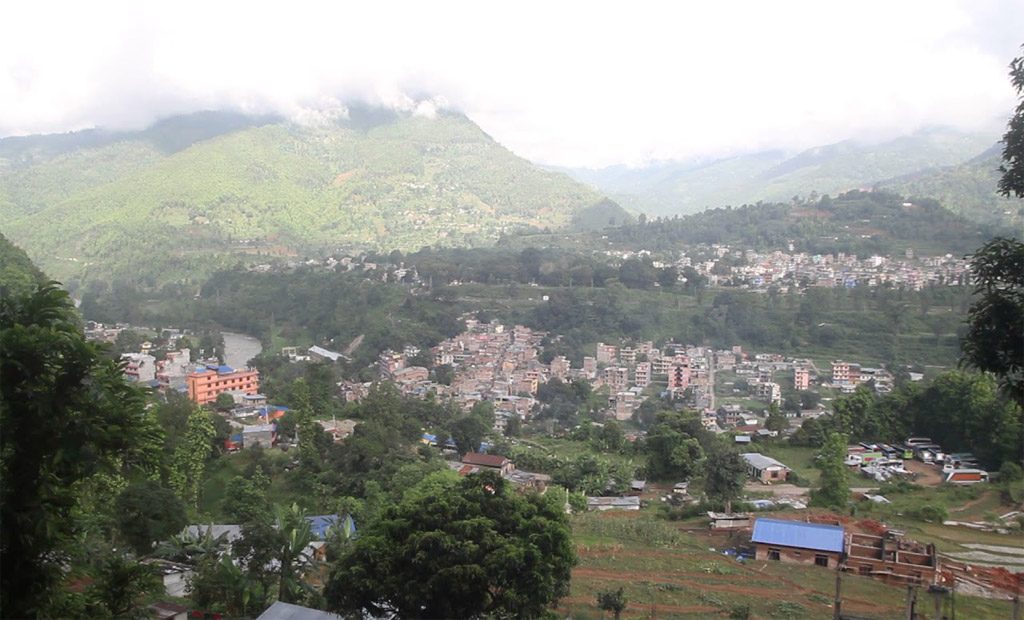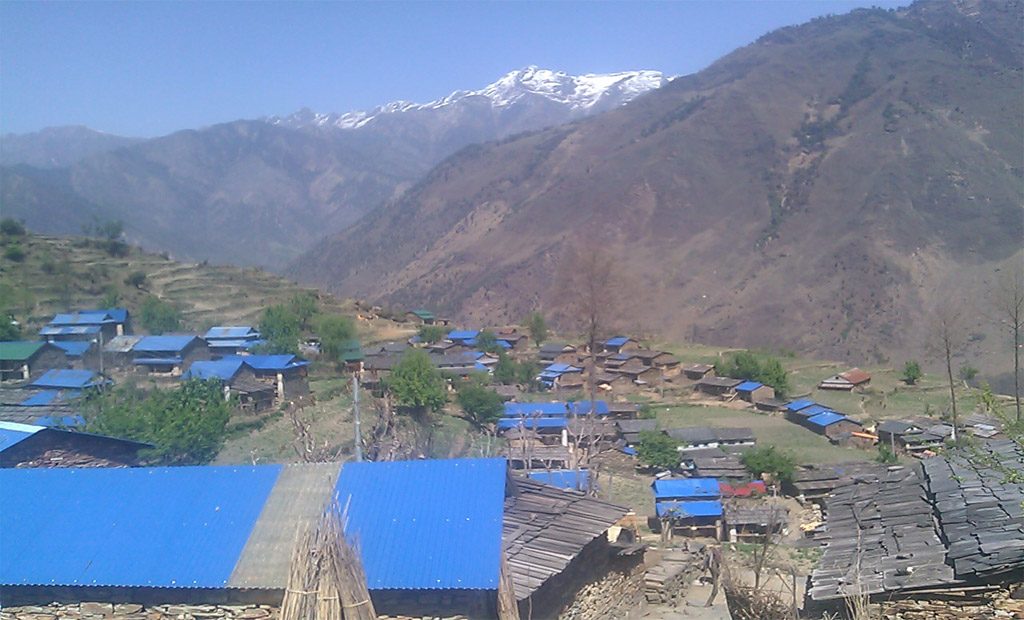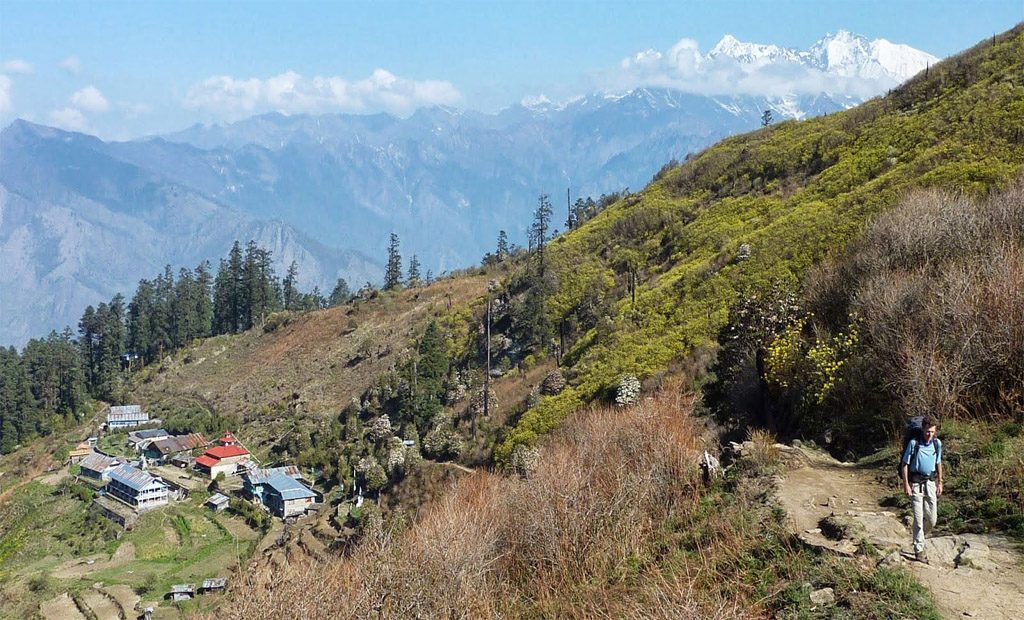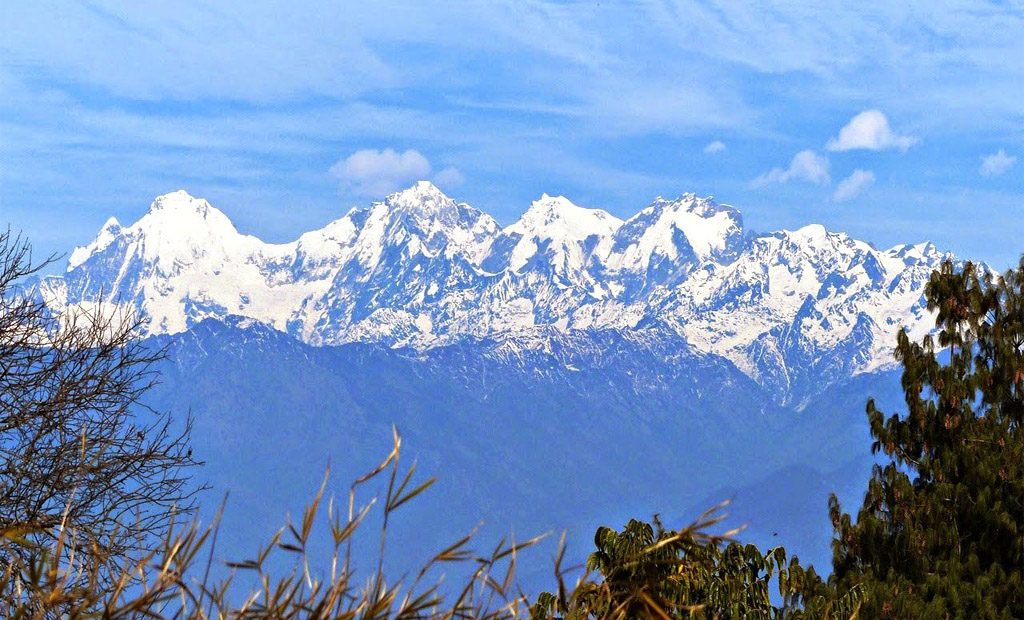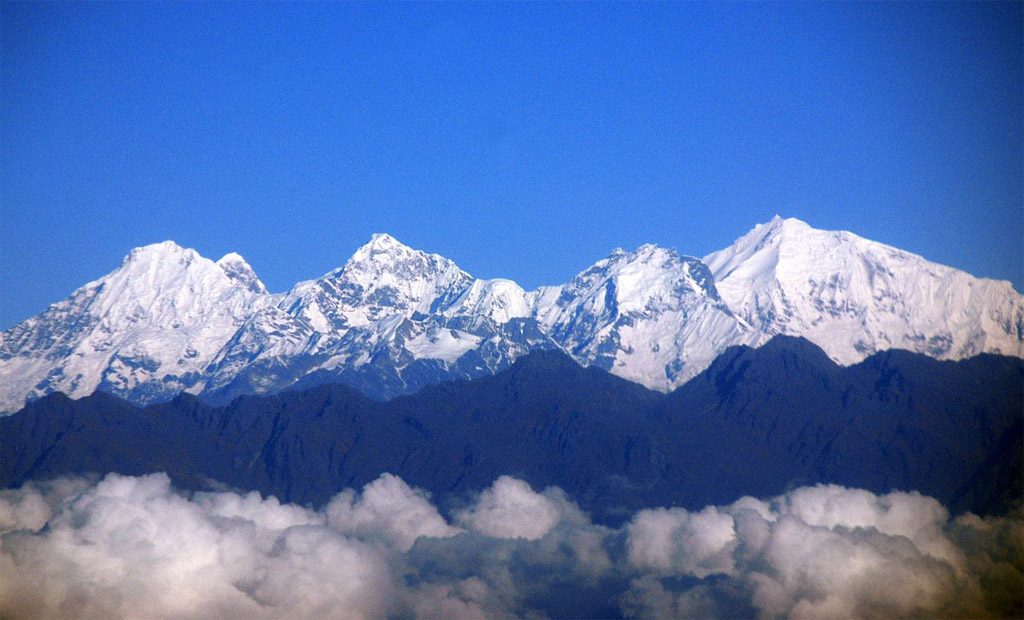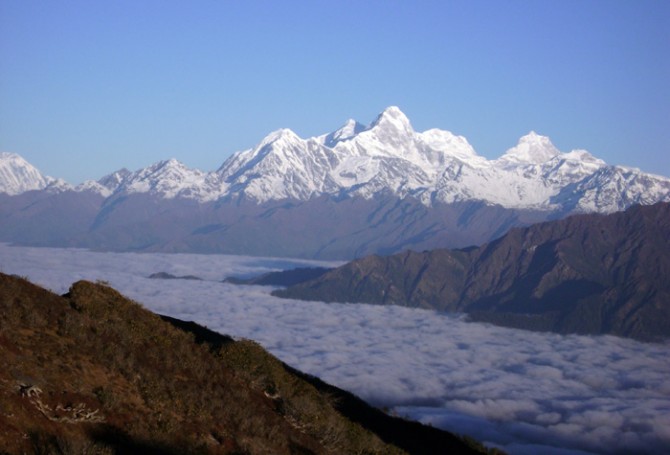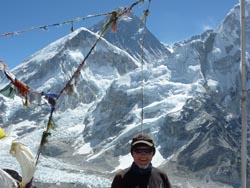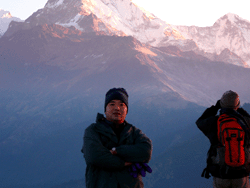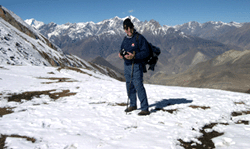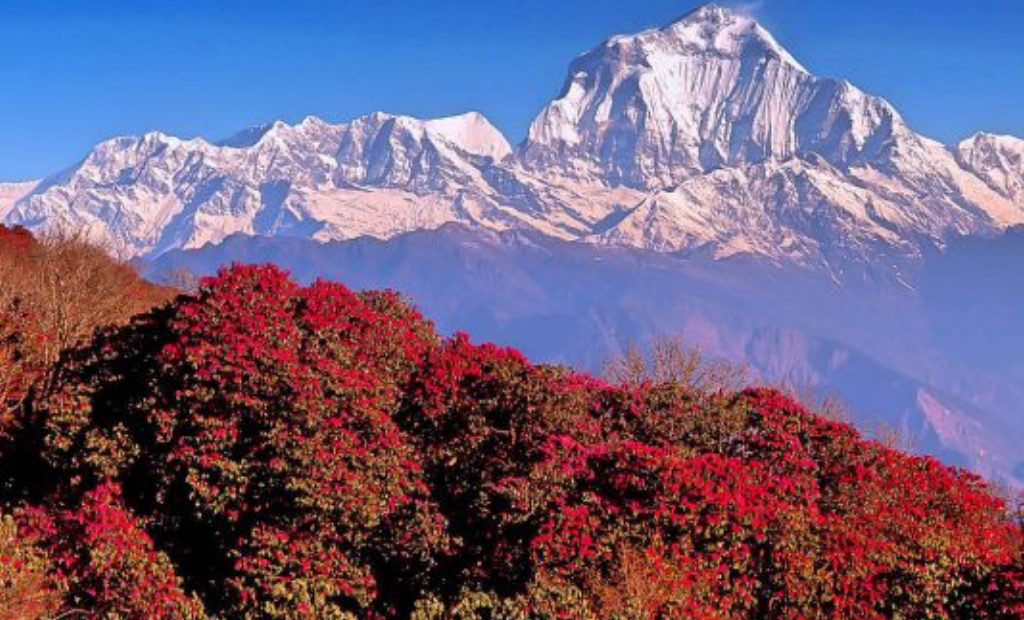Thanks to his experience and strong relationships with local lodge owners, we spent very little time between arriving at a lodge and relaxing after the day’s challenges. Comfortable rooms, well-planned meals, and the chance to rest fully each evening greatly enhanced our enjoyment of the Ghorepani–Ghandruk Trek in Nepal. Dammaru’s careful attention to these details made each day’s end as rewarding as the trekking itself.
Ganesh Himal Trekking 19 Days
Facts of the trip
| Trip Code: | GHT17 |
| Trip Duration: | 19 days |
| Max. Altitude: | 4400m |
| Grade: | Challenging |
| Program Type: | Trekking |
| Trek Start Point: | Dhunche |
| Trek End Point: | Trishuli |
| Accommodation: | Teahouse |
| Meals: | Breakfast, lunch , Dinner with tea/coffee |
| Mode of Travel: | Adventures |
| Transportation: | Car / Bus |
| Minimum Pax: | 05 |
| Best season: | September to November and March to May |
Ganesh Himal 19 -DaysTrekking
Introduction
Ganesh Himal Trekking is one of Nepal’s most culturally immersive and scenically stunning treks, located just northwest of Kathmandu. This 19-day journey offers a perfect blend of Himalayan panoramas, remote village exploration, and deep-rooted traditions.
Unlike the more commercial trails of Annapurna or Everest, the Ganesh Himal region remains delightfully unspoiled. It is ideal for those seeking authentic adventure away from the crowds. Each day reveals a new aspect of Nepal’s natural and cultural beauty—alpine meadows, rhododendron forests, sacred lakes, and terraced fields.
This trek also offers a rare chance to engage with ethnic communities like the Tamang, Gurung, and Ghale. These groups continue to preserve their ancient customs, traditional dress, and native languages. The views are equally remarkable. You’ll see Ganesh I (7,422 m), Ganesh II (7,118 m), Ganesh III (7,043 m), and Ganesh IV (7,104 m), along with the Langtang and Manaslu ranges. The journey is both spiritual and visual.
About the Trek
The 19-day Ganesh Himal Trek begins with a scenic drive from Kathmandu to Syabrubesi or Betrawati, depending on the chosen route. The trail leads you through isolated villages, hidden valleys, suspension bridges, sacred monasteries, and forested ridges. The high point of the trek usually reaches over 4,000 meters, such as the Singla Pass, Pasang La, or Pangsang La Pass, offering jaw-dropping mountain vistas.
Though the trail is physically demanding in places, it does not require technical mountaineering skills, making it accessible to moderately fit trekkers. Accommodation is often in homestays or basic teahouses, which fosters meaningful interaction with local families. Trekking in the Ganesh Himal area is not just a physical endeavor—it’s a cultural and spiritual odyssey.
Location
The Ganesh Himal region lies between the Langtang and Manaslu Himalayan ranges in central Nepal, spanning across parts of the Dhading, Rasuwa, Nuwakot, and Gorkha districts. Its relative closeness to Kathmandu makes it a hidden gem for trekkers looking for solitude without venturing too far.
This remote mountain range is named after Lord Ganesh, the elephant-headed Hindu god of wisdom and good fortune. The Ganesh Himal peaks create a majestic wall along Nepal’s northern frontier, forming a dramatic backdrop to traditional villages, river valleys, and forested trails.
The People
The region is inhabited by a mosaic of ethnic communities, including the Tamang, Gurung, Ghale, and Chhetri people. The Tamangs are predominant in this area and have rich cultural traditions rooted in Tibetan Buddhism. Their unique dress, language, and rituals make the trek a fascinating anthropological experience.
The Gurung people, known for their bravery and strong cultural identity, are found in the southern flanks of the Ganesh Himal range. The Ghale people, an indigenous group, still maintain many ancestral practices and oral traditions. These communities are known for their hospitality, spiritual beliefs, and close-knit social structures.
Trekkers often find themselves invited to join local celebrations, sample traditional foods like dhindo and gundruk, and even witness age-old customs passed down through generations.
Religion and Spirituality
The Ganesh Himal region is deeply spiritual, blending Tibetan Buddhism, Bon, and Hinduism. Sacred chortens, prayer flags, mani walls, and small shrines dot the trail, creating a spiritual atmosphere. Buddhist monasteries and nunneries provide tranquil spaces for reflection, while local shamans—known as dhami-jhankris—offer spiritual healing and blessings to those who seek them. Furthermore, the region holds profound religious significance for Hindus. Both Hindu and Buddhist pilgrims revere sacred lakes such as Kalo Kunda and Seto Kunda, reflecting the spiritual harmony between the two faiths. In addition, many locals believe that several peaks in the area represent divine beings—Ganesh I, in particular, stands as a revered embodiment of Lord Ganesh himself
Lifestyle
The lifestyle in the Ganesh Himal region is humble and self-sustaining. Villagers rely heavily on agriculture, animal husbandry, and seasonal labor. Traditional terraced farming is the backbone of the local economy, growing crops such as millet, barley, maize, and potatoes.
Life follows a seasonal rhythm. In summer, locals migrate to higher pastures with their livestock; in winter, they stay closer to their homes. Wood and yak dung are commonly used for heating and cooking. Despite modernization, many communities continue to live without electricity or running water, maintaining a strong bond with nature and tradition.
Trekking through these villages provides a firsthand look into how ancient ways of life coexist with modern changes.
Flora and Fauna
The Ganesh Himal trekking trail passes through various ecological zones, from subtropical jungles to alpine highlands. This natural diversity results in a vibrant variety of flora and fauna.
Flora:
-
Rhododendrons (especially vibrant in spring)
-
Oaks, pines, bamboo, and fir trees
-
Juniper bushes and Himalayan herbs
-
Alpine flowers at higher elevations
Fauna:
-
Red panda (rare sightings in the higher forests)
-
Himalayan black bear
-
Musk deer
-
Himalayan tahr
-
Langur monkeys
-
Numerous bird species, including the Himalayan Monal (Nepal’s national bird), pheasants, and eagles
The forested areas near the trail are protected habitats, and responsible trekking practices are essential to preserving this fragile ecosystem.
Vegetation Zones
Ganesh Himal Trekking presents a botanical journey through Nepal’s classic vegetation belts:
-
Subtropical Zone (up to 1,000 m): Includes sal forests, banana plants, and lush greenery.
-
Temperate Zone (1,000–2,500 m): Dominated by rhododendron, oak, and pine trees.
-
Subalpine Zone (2,500–3,500 m): Features birch and juniper, transitioning into grassy meadows.
-
Alpine Zone (3,500 m+): Sparse vegetation, with mosses, lichens, and hardy alpine shrubs.
Each zone showcases a different ecological niche and supports unique wildlife and flora, making the trek a paradise for botanists and nature lovers.
Atmosphere and Ambience
The atmosphere of Ganesh Himal is peaceful and spiritual. Unlike bustling trails, this region remains uncrowded, allowing trekkers to fully absorb the sights, sounds, and smells of the wild.
The air is crisp, especially above 2,500 meters, and the skies are often crystal clear, particularly in the post-monsoon and spring seasons. Early mornings bring mists that rise slowly from the river valleys, revealing panoramic mountain views. Nights are star-filled and quiet, broken only by the sounds of rustling forests or distant waterfalls.
The trail has a timeless quality. Bells from yak caravans echo through the woods, prayer flags flutter atop ridgelines, and local children greet you with wide smiles and “Namaste.” This combination of serenity and cultural depth gives Ganesh Himal an atmosphere unlike any other trek in Nepal.
Company and Nepal Freelance Guide Services
The Himalayan Realms Treks and Expedition Nepal Pvt. Ltd., with its roots in experience and commitment to quality, offers a customized approach to the Ganesh Himal Trek. Founded to promote less-traveled regions of Nepal, the company specializes in crafting authentic trekking experiences that combine adventure, cultural learning, and environmental stewardship.
For trekkers seeking a more personal and flexible journey, Nepal Freelance Guide services are an excellent option.
A licensed freelance guide from the region offers valuable insider knowledge. They understand local customs, speak the native language, and know the trails well. Their presence enhances safety, cultural connection, and overall enjoyment. They can help with translation, explain traditions, and even introduce you to villagers along the route.
Whether you choose a company-based trek or a freelance-guided experience, both options handle the logistics—permits, accommodation, meals, and transport. This allows you to focus entirely on the journey.
Alternatively, for smoother variety:
No matter if you choose a company-organized trek or go with a freelance guide, both ensure hassle-free logistics. From securing permits to arranging meals and transport, everything is covered—letting you fully enjoy the experience without worry.
Key services include:
-
Airport pickup/drop-off
-
Licensed local guides and porters
-
First aid, emergency response coordination
-
Customized itineraries
-
Eco-conscious trekking practices
Conclusion
The 19-day Ganesh Himal Trekking adventure is more than just a physical challenge; rather, it offers a profound journey into the heart of culture, spirituality, and nature. Moreover, for those eager to venture beyond Nepal’s well-trodden trails, this trek presents a rare opportunity to immerse themselves in a lesser-known yet richly rewarding Himalayan region. In addition, with its welcoming communities, majestic peaks, sacred landscapes, and ecological diversity, the route is especially suited for culturally curious and environmentally conscious travelers. Not only does the trek provide scenic beauty, but it also fosters meaningful encounters with traditional Himalayan life.
Furthermore, this journey allows trekkers to witness authentic rural lifestyles untouched by mass tourism. As you progress through the trail, you’ll encounter ancient monasteries, sacred caves, and remote villages where age-old customs still thrive. Consequently, every step brings a deeper understanding of Nepal’s spiritual and cultural tapestry.
Whether you trek with a trusted company like The Himalayan Realms Treks or choose to travel with a freelance Nepalese guide, you will undoubtedly return not only with unforgettable memories, but also with lasting friendships and a deeper connection to the Himalayan spirit. Indeed, the genuine hospitality of the local people and the purity of the landscapes will leave a profound impression on your heart.
Ultimately, for those seeking an enriching trekking experience far from the commercial bustle, Ganesh Himal Trekking is not just an option—it is a revelation.
Day 01: Trisuli to Salangkhu khola
Day 02: Salangkhu khola to Balche Village
Day 03: Balche Village to Gonga
Day 04: Gonga to Singla
Day 05: Singla to Pangsang
Day 06: Pansang to Shomthang
Day 07: Something to Jogeshwarkund Lake
Day 08: Rest day at Jgeshwarkund Lake
Day 09: Jogeshwarkund Lake to Linju Khola
Day 10: Linju Khola to Serthung Village
Day 11: Serthung village to Laba
Day 12: Laba to Mongey Thanti
Day 13: Mongey Tanti to Dumchet village
Day 14: Dhumchet village to Budhigandaki
Day 15: Bhdigandaki to Arughat Bazaar
Day 16: Rest day at Arughat Bazaar.
Day 17: Arughat Bazaar to Khachowk Danda
Day 18: Khanchowk Danda to Gorkha
Day 19: Gorkha to Kathmandu
Day 01: Trisuli to Salangkhu Khola: Drive to Trisuli in the morning and have lunch near the Trisuli electricity dam. After lunch, walk for about 3 hours to Salangkhu khola and camp.
Day 02: Salangkhu khola to Balche Village: An easy walk and then a short climb take us to Kalawale village for lunch. After lunch, proceed to the big Tamang village of Balche for overnight camp.
Day 03: Balche Village to Gonga: Take an easy walk from Balche village through a forest and camp with the peak of Langtang lirung and Gosaikunda in good view.
Day 04: Gonga to Singla: Walk through rhododendron forests to camp at singla on Rupchet. Rupchet is a cattle pasture, and Singla is the pass. The singla pass offers spectacular views of Langtang Lirung, Ganesh Himal, Baudha peak, Himal Chuli Machhapucrare, South Annapurna and Annapurna II.
Day 05: Singla to Pangsang: Walk up the Singla hill following small trails to Pangsang for the overnight camp. The view from here is spectacular.
Day 06: Pansang to Shomthang: Follow the ridge to the campsite of the day, to Shomthang. This trail gives us a close-up view of Ganesh Himal.
Day 07: Shamthang to Jogeshwarkund Lake: Now undertake a gradual climb for the day to reach the campsite at Jogeshwarkund Lake. (Sometimes Shamthang to Jogeshwarkund Lake is not possible due to army training.)
Day 08: Rest day at Jgeshwarkund Lake: – Interested people can do rock and peak climbing above 5000m.
Day 09: Jogeshwarkund Lake to Linju Khola: – Descend to Linju Khola for the next camp.
Day 10: Linju Khola to Serthung Village: Walk down through pine and rhododendron forests to Sherthung village and set up camp with good views of mountains all around. Shjerthung is a Tamang cultural village.
Day 11: Serthung village to Laba: A short flat trail and then a gradual descent passing through Barang village, followed by crossing the Akhu Khola, takes you to Laba, a big Tamang village.
Day 12: Laba to Mongey Thanti: A slight climb to cross a hill and then descend through forests to camp at Mongey Thanti.
Day 13: Mongey Tanti to Dumchet village: A gradual walk down through forests with lunch by the side of a stream brings us to the camp at Dumchet village.
Day 14: Dhumchet village to Budhigandaki: Take a gradual walk today to Baseri and camp near the Budhigandaki river.
Day 15: Bhdigandaki to Arughat Bazaar: (This is a part of the Manaslu trek): Walk along the bank of the Budhigandaki river and stop for the night. There are teashops and a police station. A nice village indeed.
Day 16: Rest day at Arughat Bazaar.
Day 17: Arughat Bazaar to Khachowk Danda: Gradually climb the Khanechowk Danda, crossing the Muktii Khola, and camp for the night.
Day 18: Khanchowk Danda to Gorkha: Cross the ridge today and walk gradually uphill to Gorkha, camping near the old place.
Day 19: Gorkha to Kathmandu: Have a sightseeing tour of Gorkha palace, the palace of King Prithivi Narayan Shah, who united Nepal in 1881 AD and visit the Bazaar and then drive back to Kathmandu.
| Start Date | End Date | Price In US Dollar($) | AVAILABILITY | Booking |
|---|
AVAILABILITY OPTIONS
OPENED: This date is available and open for bookings.LIMITED: There are very limited number of available places on this departure. Immediate booking.
GUARANTEED: We have reached minimum numbers and this trip is guaranteed to depart.
CLOSED: This date is currently unavailable. Please contact us, if you are interested in travelling on this date.
Your Program Duration = 19 days Days
All the Prices are in GBP (£) Per Person.
Cost Include
Cost Is Included
- 2 Night accommodation in Kathmandu with B/B basic plan
• Kathmandu to Syabrubeshi transfer by bus.
• All airport and hotel transfers
• National permit & TIMS permit (Trekking Information Management System)
• Accommodation, food and Tea/coffee during the trek
• Guide: including salary, insurance, equipment, flight, food and lodging
• Porter: including salary, insurance, equipment, food and lodging
• Transfer from Melamche Bazar to Kathmandu by private Car
• For guests: down jacket, Good sleeping bag (down jacket and sleeping bag are to be returned after trip completion)
• All government and local taxes
Cost Exclude
Cost Is Not Included
• Food in Kathmandu (Lunch & Dinner)
• Bakery food during the trek. When you eat in the bakery, you need to pay by yourself
• Nepal Visa fee
• International airfare from your country to Kathmandu and from Kathmandu
• Extra night accommodation in Kathmandu
• Travel and rescue insurance if guests get mountain sickness and need a rescue helicopter.
• Personal expenses example (phone calls, laundry service, bar bills, battery recharge, extra porters, bottle of boiled water, shower, etc.)
• Tips for guide and porters
our testimonials
-
Testimonial from Bell Howse with the Hothouse Group Australia
Dammaru Niraula was our guide and confidant for our recent visit to Nepal. We went on a humanitarian visit to build a hothouse in the village of Phortse in the Khumbu region of Nepal but also included some trekking on a personal level before and after our project.… -
Testimonial Overview: Ian Thwaity, Australia
This testimonial is provided by Ian Thwaity from Australia, who has worked closely with Dammaru Prasad Niraula, a freelance trekking guide and trip leader from Nepal, over a period of three years. Through multiple treks and a…
-
Dear Dammaru I have been trekking to Ghorepani poon hill on Jan 07 for 6 days with Mr. Dammaru. Poonhill is so beautiful, so all I can do is just taking pictures on poon hill. If you were planning to trek in Nepal, I…
-
Overview: Philip Pomeroy Holcot, Northamptonshire, UK.
Introduction: A Memorable Journey to the Annapurna Circuit
In 2004, I was fortunate to join a close-knit group of nine friends from Northamptonshire in the United Kingdom on the Annapurna Circuit Trek in Nepal. Together, we set out on what became one of…
-
Overview: Peter Smith & Jane Fairlie,
South Australia Ghorepani–Ghandruk Trek, Nepal (October 2006)
Introduction:
The
-
Testimonial from Bell Howse with the Hothouse Group Australia
Dammaru Niraula was our guide and confidant for our recent visit to Nepal. We went on a humanitarian visit to build a hothouse in the village of Phortse in the Khumbu region of Nepal but also included some trekking on a personal level before and after our project. Dammaru was a vital link in getting the project off the ground and then as a support person in Nepal before, during, and after. He completed the following tasks with the utmost professionalism and patience. Arranged the transfer of a large number of funds from an Australian bank account to a Nepalese bank account. Communications with the village before we arrived to ensure the walls were built. Organized our itinerary and necessary bookings for the trekking part of our journey for 8 adults. Once we arrived in Nepal, he then assisted us in purchasing all the gear we needed for the finishing of the hothouse. e.g., polycarbonate roof sheeting and the many other bits of hardware necessary. Transport of the roofing, etc., to Phortse village via helicopter, plane, yak, and porter. As well as being a part of the project, Dammaru also was our trekking guide for the duration of our trip of 5 weeks. He organized everything for us from the hotel in Kathmandu and everything in between our trek to base camp. He is honest and reliable and always puts the customer first. I would have no hesitation in recommending Dammaru to anyone who is considering a trip to Nepal. -
Testimonial Overview: Ian Thwaity, Australia
This testimonial is provided by Ian Thwaity from Australia, who has worked closely with Dammaru Prasad Niraula, a freelance trekking guide and trip leader from Nepal, over a period of three years. Through multiple treks and a major humanitarian project in the Solu Khumbu region, Ian experienced Dammaru’s leadership, professionalism, and personal integrity firsthand.
Long-Term Association with Dammaru Niraula
I have had an association with Dammaru Niraula over the last three years, during which time I completed two significant trekking journeys under his guidance. From the very beginning, it was clear that Dammaru was not only an experienced trekking guide but also someone deeply committed to responsible trekking, safety, and community welfare.
Our relationship developed through shared challenges in remote Himalayan terrain and through collaboration on a long-term community project. Over time, trust and respect naturally grew, based on his consistent performance and genuine character.
First Trek Experience: Gokyo–Phortse–Everest Base Camp
My first trek with Dammaru Niraula was in the Solu Khumbu region, following a thoughtfully designed route through Gokyo, Phortse, and Everest Base Camp. This area is known for its rugged landscapes, traditional Sherpa settlements, and dramatic high-mountain scenery. From the outset, our group requested an itinerary that avoided the main tourist trails wherever possible and included more remote and less-traveled sections of the region.
Dammaru carefully tailored the trek to meet these expectations. His planning reflected a deep understanding of local geography, seasonal weather patterns, altitude considerations, and logistical challenges. The chosen route allowed us to cross quieter trails and experience a more authentic side of the Himalayas, while still reaching iconic destinations such as Gokyo and Everest Base Camp.
Throughout the journey, his knowledge of the region was evident in every decision. The balance between adventure, safety, and cultural exposure was handled with great care. By keeping us away from crowded trekking corridors whenever possible, Dammaru delivered a trekking experience that felt personal, peaceful, and deeply connected to the landscape and communities of the Solu Khumbu.
Knowledge, Planning, and Safety Management
Throughout the first trek, Dammaru’s knowledge of the area was extremely impressive. He was always aware of trail conditions, weather changes, altitude considerations, and potential risks. Safety was never treated casually. It was always his highest priority.
He monitored our health daily, adjusted walking pace when necessary, and made decisions that balanced adventure with responsibility. His calm and confident leadership created a strong sense of trust within the group. At no point did we feel rushed or exposed to unnecessary risk.
Second Trek: A Humanitarian Hothouse Project
The second trek I undertook with Dammaru took place two years later and was far more complex in nature. This journey marked the culmination of a long-term humanitarian project aimed at building hothouses in a village deep in the Solu Khumbu region, specifically in Phortse. The project is associated with www.himalyanhothouse.org.
This trek was not only about reaching a destination. It involved transporting materials, coordinating people, and working closely with a local community to ensure the success of the project.
Pivotal Role in Project Development
Dammaru played a pivotal role in every stage of the hothouse project. He assisted in developing local contacts, sourcing construction materials, and helping to manage project finances. His local knowledge and trusted relationships were essential to moving the project forward.
During the preparation phase, we found Dammaru to be honest, prompt, and extremely hardworking. He understood our goals clearly and showed flexibility and problem-solving skills whenever challenges arose. His commitment to the project went well beyond his duties as a trekking guide.
Coordination and Leadership During the Trek
During the trek itself, Dammaru coordinated seven group members, six porters, and an additional climbing guide. Managing such a team in remote mountain conditions requires strong organizational skills, patience, and clear communication.
He handled logistics smoothly, ensured fair treatment of porters, and maintained group morale throughout the journey. His leadership ensured that both trekking objectives and project responsibilities were completed efficiently and safely.
Interpreter and Community Liaison in Phortse
One of Dammaru’s most valuable contributions was his role as an interpreter and liaison with the people of Phortse village. Communication with local residents was essential for the success of the hothouse project.
Dammaru bridged cultural and language gaps with sensitivity and respect. He ensured that the villagers fully understood the project and that our group respected local customs and traditions. This cooperation created trust and long-term value for the community.
Personal Character and Humanitarian Values
On a personal level, Dammaru is one of the most genuine individuals I have met. He is a man with a big heart and a sincere commitment to helping others. He shared our passion for the hothouse project and fully embraced its humanitarian ideals.
His motivation was not financial or personal recognition. Instead, it was driven by service, responsibility, and care for both clients and local communities. These qualities are rare and deeply admirable.
Consistent Focus on Safety and Care
Once again, throughout the entire trek, our safety was Dammaru’s primary concern. Whether dealing with weather changes, physical fatigue, or logistical challenges, he always placed the well-being of the group first.
This consistent focus on safety, combined with his calm demeanor, created an environment where we could fully trust his decisions and enjoy the experience.
Professional Philosophy: “Service Is Most Important”
A phrase often used by Dammaru perfectly summarizes his professional ethic:
“Service is most important.”This philosophy is reflected in every aspect of his work. From trek planning and execution to community engagement and client care, his actions consistently align with this belief.
Final Recommendation
I would not hesitate to strongly recommend the services of Dammaru Prasad Niraula to anyone planning a trek or similar activity in Nepal. Whether your goal is adventure, exploration, or humanitarian work, Dammaru offers professionalism, integrity, and heartfelt commitment.
Working with him is not just about trekking in the Himalayas. It is about shared values, mutual respect, and meaningful experiences that leave a lasting impact.
- Dear Dammaru I have been trekking to Ghorepani poon hill on Jan 07 for 6 days with Mr. Dammaru. Poonhill is so beautiful, so all I can do is just taking pictures on poon hill. If you were planning to trek in Nepal, I would recommend you as one choice. His personality and professional guide skill makes me fun of Trekking and Nepal. so I am planning to go to Nepal again this August. He may meet all demand of you request on your trekking trip even though you join in the big group. Because he has more over 10 years experience of trekking guide for Many English and Japanese speaker. Actually, I have never met such a good Japanese speaker guide and I had no chance to speak in English with him. I can recommend him to all people who need great experience guide with English or Japanese. so you can get satisfaction for a great guide. Very Thanks,
-
Overview: Philip Pomeroy Holcot, Northamptonshire, UK.
Introduction: A Memorable Journey to the Annapurna Circuit
In 2004, I was fortunate to join a close-knit group of nine friends from Northamptonshire in the United Kingdom on the Annapurna Circuit Trek in Nepal. Together, we set out on what became one of the most memorable journeys of our lives. For many of us, this trek was a lifelong ambition rather than a casual holiday. The Annapurna Circuit Trek was already renowned as one of the world’s classic long-distance routes. It was celebrated for its dramatic mountain scenery, rich cultural encounters, and demanding terrain.
Our journey, however, carried added challenges. Most members of our group were approaching, or had already passed, the age of sixty. We knew the trek would test not only our physical strength but also our mental resilience. Adapting to high-altitude conditions would be essential. From the very beginning, we understood that success would depend on expert guidance, careful pacing, and a deep respect for the mountains.
Understanding the Challenge of Age and Altitude
Apart from one younger member, our group consisted mainly of trekkers in their late fifties and sixties. Although we were all reasonably fit and experienced walkers, we never underestimated the challenges ahead, especially the crossing of Thorong La Pass. Thorong La rises to an altitude of 5,416 meters (17,769 feet) and ranks among the highest trekking passes in the world. We understood that altitude sickness can affect anyone, regardless of fitness, and that age can increase vulnerability if proper acclimatization does not take place. Long before we arrived in Nepal, we discussed these risks openly and prepared ourselves mentally for the possibility that not everyone might be able to complete the trek. This awareness made us especially conscious of the importance of choosing the right leader—someone with both technical knowledge and genuine concern for the wellbeing of every group member.Leadership Under Dammaru Niraula
Our group was led by Dammaru Niraula, a name that has remained deeply etched in our memories ever since. From our first meeting with him, it was clear that he possessed qualities far beyond basic guiding skills. He carried himself with quiet confidence, never seeking attention yet commanding respect through his calm presence and thoughtful approach. Dammaru did not treat us as clients on a fixed schedule; instead, he regarded us as individuals, each with different strengths, limitations, and expectations. His leadership style was reassuring rather than authoritative, which immediately put us at ease. For a group of older trekkers stepping into an unfamiliar environment, this sense of trust was invaluable.Gentle Introduction to Lower Altitudes
One of the most impressive aspects of Dammaru’s leadership was the way he introduced us gradually to trekking in the Himalayas. The early stages of the Annapurna Circuit were approached with deliberate care. Rather than pushing us hard from the outset, he allowed our bodies time to adapt to the increasing altitude and daily walking routines. Distances were manageable, rest breaks were well timed, and overnight stops were chosen thoughtfully. Dammaru constantly observed how each member of the group was coping, adjusting the pace when necessary and offering quiet encouragement when fatigue began to show. This gentle introduction built both physical strength and group confidence, laying a strong foundation for the more demanding days ahead.Progression to Longer and More Arduous Days
As the trek progressed and our confidence grew, Dammaru gradually encouraged us to take on longer and more challenging days. This progression felt natural rather than forced. By the time the terrain became steeper and the air thinner, we were better prepared both physically and mentally. Dammaru had an exceptional ability to judge when to push gently and when to hold back. He never allowed competitiveness or pride to override common sense. Instead, he emphasized steady progress, proper hydration, and attentive listening to one’s own body. This balanced approach ensured that even the more demanding stages of the trek felt achievable rather than overwhelming.Acclimatization at Manang
Our stay in Manang proved to be a pivotal moment in the success of the entire trek. Recognizing the importance of acclimatization before attempting Thorong La, Dammaru strongly encouraged us to spend an extra day there. Rather than resting passively, he organized a day hike up the lower slopes of Gangapurna and Annapurna III. This acclimatization walk allowed our bodies to adjust gradually to higher elevations while still returning to a lower altitude for the night. The views were breathtaking, but more importantly, the hike played a crucial role in preparing us safely for what lay ahead.Altitude Safety Awareness
Following the acclimatization hike in Manang, Dammaru encouraged us to attend an altitude safety lecture. This session was both informative and reassuring. We learned to recognize the early signs of altitude sickness, understood the importance of reporting symptoms honestly, and gained clarity on why gradual ascent was essential. Dammaru reinforced these lessons throughout the trek, regularly checking in with each of us and never dismissing even minor concerns. His commitment to altitude safety was unwavering, and it became increasingly clear that our well-being was always his highest priority.Successfully Crossing Thorong La
As we approached Thorong La, the significance of Dammaru’s careful planning became fully apparent. The pass was demanding, both physically and mentally, but thanks to proper acclimatization and steady pacing, every member of our group was able to cross successfully. We knew that altitude sickness forces many trekkers to turn back or descend. Without Dammaru’s attentive guidance, we believe some of us might have faced the same outcome. Standing on the summit of Thorong La marked a moment of profound achievement. Expert leadership and genuine care made that success possible.Gratitude to Dammaru and His Sherpa Team
We remain eternally grateful to Dammaru and his team of Sherpas, whose quiet efficiency and constant support played an essential role in our success. Their teamwork, professionalism, and warmth created a positive atmosphere throughout the trek. Like many Nepalese, Dammaru possesses a gentle and respectful nature, combined with a subtle but delightful sense of humor. His ability to lift spirits during difficult moments added an invaluable human touch to the journey.Personal Qualities and Professional Excellence
At first, Dammaru may seem shy and reserved. This impression soon fades as you see how carefully he looks after his guests. He has a remarkable ability to judge individual temperaments and physical limits. When needed, he adjusts the itinerary smoothly and without drawing attention to the change. After only a few days under his guidance, it becomes clear that you are in the care of an experienced and highly capable mountain professional. His strength lies not only in his deep knowledge of the terrain, but also in his empathy and patience.Final Recommendation
I cannot recommend Dammaru Niraula highly enough. Our experience on the Annapurna Circuit was greatly enriched by his leadership. Our safe and successful crossing of Thorong La stands as a clear testament to his expertise. I am confident he will continue to provide outstanding trekking services in the Himalayas for many years. For anyone seeking a guide who combines professionalism, safety, compassion, and deep local knowledge, Dammaru Niraula represents the very best of Nepal’s mountain guiding tradition. -
Overview: Peter Smith & Jane Fairlie,
South Australia Ghorepani–Ghandruk Trek, Nepal (October 2006)
Introduction:
The Ghorepani–Ghandruk Trek, Nepal, was the journey we had dreamed of for our first visit to the Himalayas in October 2006. From the very beginning, we wanted to experience Nepal in a personal and meaningful way, avoiding large tour groups and opting for a customized trekking adventure. We were eager to connect with the landscape, explore traditional villages, and meet local communities along the way. After careful research online and speaking with previous trekkers, the Ghorepani–Ghandruk Trek, Nepal, stood out for its stunning mountain views, rich cultural experiences, and a thoughtfully paced itinerary perfect for first-time trekkers.
Choosing a Customized Trekking Company
Before leaving, we spent weeks researching trekking options online, reading reviews, and speaking with travelers who had completed the Ghorepani–Ghandruk Trek, Nepal. We sought a company that specialized in personalized tours rather than mass-group treks. This led us to Himalayan Holidays, based in Kathmandu. Their reputation for organizing tailored experiences reassured us that the Ghorepani–Ghandruk Trek, Nepal, would meet our expectations and provide a memorable adventure.
Physical Preparation and Fitness Concerns
Living in a flat region meant that preparing for the Ghorepani–Ghandruk Trek, Nepal, was a real challenge. We improvised by walking up and down a 700-meter hill on weekends, hoping it would prepare us for the trek’s climbs. Even with this preparation, we were anxious about altitude, long walking days, and our endurance for the Ghorepani–Ghandruk Trek, Nepal.
Meeting Our Guide: Dammaru Niraula
Upon arrival in Kathmandu, we met our guide, Dammaru Niraula. From the first meeting, our concerns melted away. Dammaru’s calm confidence and deep knowledge made us feel secure about our upcoming adventure. He listened carefully to our worries and reassured us that the Ghorepani–Ghandruk Trek, Nepal could be adjusted to match our fitness levels. His focus on safety, comfort, and enjoyment ensured that every day of the Ghorepani–Ghandruk Trek, Nepal, was a perfect blend of adventure, culture, and relaxation.
Managing the Trekking Pace with Care
Once the trek began, Dammaru demonstrated exceptional skill in managing the daily walking pace. Without being overly noticeable, he carefully controlled the tempo so that the enjoyment factor always exceeded any physical discomfort. Rest stops were well timed, days were sensibly planned, and the overall rhythm of the Ghorepani–Ghandruk Trek, Nepal, felt natural rather than forced. We never felt rushed, pressured, or exhausted beyond our comfort level. This thoughtful pacing allowed us to fully appreciate the stunning scenery along the Ghorepani–Ghandruk trails.
Genuine Connection with Local Communities
One of the most memorable aspects of trekking with Dammaru was his genuine relationship with local people. His interactions with villagers, lodge owners, and tea house staff were warm, respectful, and authentic. Because of this, we never felt like intruders along the Ghorepani–Ghandruk Trek, Nepal. We felt welcomed and at ease wherever we went, and these interactions enriched our experience, giving us a deeper understanding of daily life along the trek.
Tea House Arrangements and Comfort
After a long day on the trail, the ability to rest and recover quickly becomes essential. Throughout the Annapurna Circuit Trek, Dammaru’s strong relationships and negotiation skills with local teahouse owners made a noticeable difference. Upon arrival each afternoon, our accommodation was already arranged, clean, and appropriate for our group’s age and comfort requirements. This efficiency removed unnecessary stress and allowed us to settle in without delay.
Rooms were chosen with care, often positioned away from noise and cold drafts, ensuring better sleep at altitude. Dammaru also paid close attention to dining arrangements, encouraging warm, nourishing meals and adequate hydration. His calm presence and thoughtful planning created a sense of security at the end of each day. These seemingly small details greatly enhanced our overall trekking experience. They allowed us to conserve energy, recover properly, and face the following day’s walk with renewed confidence and enthusiasm.
Efficient Organization and Meals
Professionalism and Knowledge Throughout the Trek
Dammaru’s professionalism was faultless from start to finish. Throughout the trek, he shared a wealth of information about Nepal’s history, culture, flora, and fauna. His explanations helped us understand not only the landscape but also the traditions and daily lives of the people along the Ghorepani–Ghandruk Trek, Nepal. This knowledge transformed the trek from a simple walking holiday into an educational and culturally rich experience.
Personality, Humor, and Companionship
Beyond his guiding skills, Dammaru was a delightful traveling companion. His cheeky grin and sense of humor brought lightness and laughter to each day, even during challenging moments on the trail. He balanced professionalism with friendliness perfectly. Conversations flowed easily, laughter was frequent, and his presence made the Ghorepani–Ghandruk Trek, Nepal, feel relaxed, enjoyable, and memorable.
Overall Experience and Lasting Impression Our dealings with Dammaru exceeded all expectations. Every concern we had before arriving in Nepal was addressed with patience, skill, and genuine care. We felt safe, supported, and well looked after throughout the entire Ghorepani–Ghandruk trek. The experience was challenging in a rewarding way and deeply enriching on both a personal and cultural level. Nepal left a lasting impression on us, not only because of its natural beauty but also because of the way we were guided through it.Final Reflections and Recommendation
The Ghorepani–Ghandruk Trek, Nepal, gave us an unforgettable introduction to the Himalayas and the rich culture of Nepal. From breathtaking mountain views to charming villages along the trail, every moment of the trek felt enriched by our guide’s expertise and care. Dammaru Niraula’s professionalism and attention to detail stood out throughout the journey. His friendly guidance ensured that our trek through Nepal’s Ghorepani–Ghandruk region remained safe and enjoyable.
He carefully managed the walking pace and arranged accommodations efficiently. He also helped us connect genuinely with local communities. These efforts made the Ghorepani–Ghandruk Trek in Nepal smooth, memorable, and deeply rewarding. Nepal’s natural beauty only enhanced the experience.
Nepal’s beauty is undeniable, but traveling with the right guide transforms the journey into something extraordinary. We left with lasting memories, new friendships, and a profound appreciation for the Himalayas. We would wholeheartedly recommend Dammaru Niraula to anyone planning the Ghorepani–Ghandruk Trek, Nepal, confident that he will make their adventure just as remarkable as ours.
Recent News and events
-
NEWS & EVENTS Rasuwagadhi Border Closed for Kailash Tour Due to Heavy Rain—Transportation Now Diverted via… Aug-7-2025
© 2025 Nepal Freelance guide | All rights reserved Website by: BESTNEPAL
